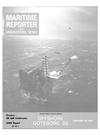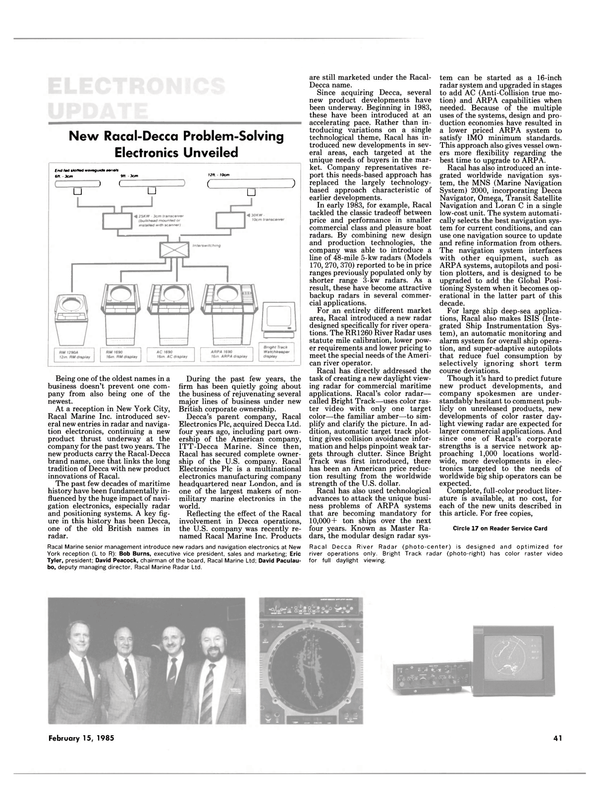
New Racal-Decca Problem-Solving Electronics Unveiled
Being one of the oldest names in a business doesn't prevent one company from also being one of the newest.
At a reception in New York City, Racal Marine Inc. introduced several new entries in radar and navigation electronics, continuing a new product thrust underway at the company for the past two years. The new products carry the Racal-Decca brand name, one that links the long tradition of Decca with new product innovations of Racal.
The past few decades of maritime history have been fundamentally influenced by the huge impact of navigation electronics, especially radar and positioning systems. A key figure in this history has been Decca, one of the old British names in radar.
During the past few years, the firm has been quietly going about the business of rejuvenating several major lines of business under new British corporate ownership.
Decca's parent company, Racal Electronics Pic, acquired Decca Ltd.
four years ago, including part ownership of the American company, ITT-Decca Marine. Since then, Racal has secured complete ownership of the U.S. company. Racal Electronics Pic is a multinational electronics manufacturing company headquartered near London, and is one of the largest makers of nonmilitary marine electronics in the world.
Reflecting the effect of the Racal involvement in Decca operations, the U.S. company was recently renamed Racal Marine Inc. Products are still marketed under the Racal- Decca name.
Since acquiring Decca, several new product developments have been underway. Beginning in 1983, these have been introduced at an accelerating pace. Rather than introducing variations on a single technological theme, Racal has introduced new developments in several areas, each targeted at the unique needs of buyers in the market.
Company representatives report this needs-based approach has replaced the largely technologybased approach characteristic of earlier developments.
In early 1983, for example, Racal tackled the classic tradeoff between price and performance in smaller commercial class and pleasure boat radars. By combining new design and production technologies, the company was able to introduce a line of 48-mile 5-kw radars (Models 170, 270, 370) reported to be in price ranges previously populated only by shorter range 3-kw radars. As a result, these have become attractive backup radars in several commercial applications.
For an entirely different market area, Racal introduced a new radar designed specifically for river operations.
The RR1260 River Radar uses statute mile calibration, lower power requirements and lower pricing to meet the special needs of the American river operator.
Racal has directly addressed the task of creating a new daylight viewing radar for commercial maritime applications. Racal's color radar— called Bright Track—uses color raster video with only one target color—the familiar amber—to simplify and clarify the picture. In addition, automatic target track plotting gives collision avoidance information and helps pinpoint weak targets through clutter. Since Bright Track was first introduced, there has been an American price reduction resulting from the worldwide strength of the U.S. dollar.
Racal has also used technological advances to attack the unique business problems of ARPA systems that are becoming mandatory for 10,000+ ton ships over the next four years. Known as Master Radars, the modular design radar system can be started as a 16-inch radar system and upgraded in stages to add AC (Anti-Collision true motion) and ARPA capabilities when needed. Because of the multiple uses of the systems, design and production economies have resulted in a lower priced ARPA system to satisfy iMO minimum standards.
This approach also gives vessel owners more flexibility regarding the best time to upgrade to ARPA.
Racal has also introduced an integrated worldwide navigation system, the MNS (Marine Navigation System) 2000, incorporating Decca Navigator, Omega, Transit Satellite Navigation and Loran C in a single low-cost unit. The system automatically selects the best navigation system for current conditions, and can use one navigation source to update and refine information from others.
The navigation system interfaces with other equipment, such as ARPA systems, autopilots and position plotters, and is designed to be upgraded to add the Global Positioning System when it becomes operational in the latter part of this decade.
For large ship deep-sea applications, Racal also makes ISIS (Integrated Ship Instrumentation System), an automatic monitoring and alarm system for overall ship operation, and super-adaptive autopilots that reduce fuel consumption by selectively ignoring short term course deviations.
Though it's hard to predict future new product developments, and company spokesmen are understandably hesitant to comment publicly on unreleased products, new developments of color raster daylight viewing radar are expected for larger commercial applications. And since one of Racal's corporate strengths is a service network approaching 1,000 locations worldwide, more developments in electronics targeted to the needs of worldwide big ship operators can be expected.
Complete, full-color product literature is available, at no cost, for each of the new units described in this article. For free copies, Circle 17 on Reader Service Card
Read New Racal-Decca Problem-Solving Electronics Unveiled in Pdf, Flash or Html5 edition of February 15, 1985 Maritime Reporter
Other stories from February 15, 1985 issue
Content
- Imi-Tech Awarded $300,000 In Navy Research Contracts page: 4
- Two More U.S. Lines Containerships Delivered Early By Daewoo Yard page: 5
- Whitey Introduces New Severe Service Valve page: 5
- Loftus Succeeds Graham As Vice President-Sales For Moran Towing page: 6
- Coburn Appointed Area Manager For Sea-Land— Martin Named Port Manager page: 6
- Gulf Coast Trailing Dredge Under Construction At Twin City Shipyard page: 6
- Laviola And Adelman Named Corporate Vice Presidents At M. Rosenblatt & Son Firm page: 6
- Chaplin Appointed Vice President-Development For Bell Aerospace Textron page: 7
- Szczypinski Named Vice President Of Techmatics page: 7
- Folk Signs License Agreement With Renk For Reverse-Reduction Drives page: 8
- Mitsui Delivers Bulk Carrier To Kohoi Shipping Of Hong Kong page: 8
- W.A.I.T.! Alloy Identification Kits Introduced By Fenner page: 8
- Tracor Awarded $16-Million Contract For Automated Communications System page: 10
- St. Pe Succeeds Erb As President of Ingalls Shipbuilding Division page: 10
- FMC Offers Brochure On High-Capacity Centrifugal Pumps page: 11
- OFFSHORE GOTEBORG 85 page: 12
- FMC Offers Compact Turbine-Driven Centrifugal Boiler-Feed Pump page: 19
- Society Of Marine Consultants Reviews Arctic Oil Transportation page: 20
- Amor And Frayling Named Vice Presidents For Lister Diesels page: 20
- Navy Buys 11 More Ships For Ready Reserve Fleet At Cost Of $82.5 Million page: 21
- Peterson Yard Launches Another Rescue/Salvage Vessel For Navy page: 22
- MarAd Approves Sale Of Delta Line To U.S. Lines page: 22
- Boeing Sells Jetfoil To Canadian Company For Marine Research page: 22
- New York SNAME Meeting Hears Paper On Shipboard Computers page: 22
- Third Rowan Gorilla Drilling Rig Delivered By Marathon LeTourneau page: 28
- Morris Guralnick Firm Awarded Two Contracts For Conversion Designs page: 29
- Navy Awards NASSCO $14 Million For Overhaul Of Tank Landing Ship page: 29
- OIL SPILL CONFERENCE page: 30
- FAIRNESS, SIMPLICITY AND ECONOMIC GROWTH page: 37
- New Racal-Decca Problem-Solving Electronics Unveiled page: 41
- SweetWater RO Unit Selected For Antarctic Expedition By British page: 42
- Wartsila Delivers Combination Tanker xTavi' To Neste Oy page: 42
- Sea-Land Cranes Complete Trip From Japan To Port Of Tacoma page: 47
- General Thermodynamics Offers Free Literature On 300-A BMEP Balancer page: 48
- Worthington Offers Free Publication On Fire-Fighting Monitors page: 48
- Nelson Industries Introduces xBilge Boy' Oily Water Separator page: 51


